Welcome To China Business Top 100 Forum!!
On November 28, 2020, the 20th Summit Forum of Top 100 Chinese Listed Companies was held in Beijing. Zheng Xinli, Chairman of the Summit Forum of Top 100 Chinese Listed Companies and former Deputy Director of the Policy Research Office of the Central Committee of the Communist Party of China (CPC), delivered a keynote speech titled "Insisting on the Expansion of Domestic Demand as the Strategic Pivot Point" at the forum.
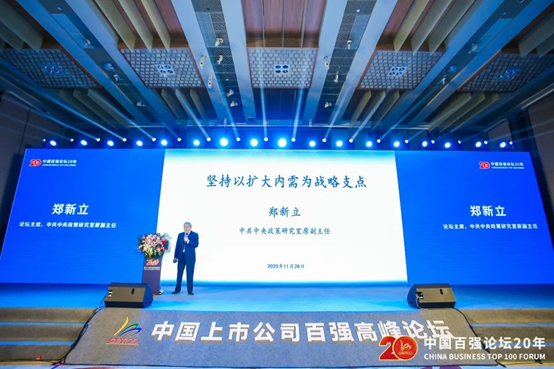
The following is the full text of the speech.
Ladies and gentlemen, comrades, good afternoon!
First of all, I would like to congratulate the 20th Summit Forum of Top 100 Listed Companies in China! I would like to take this opportunity to talk about my experience in studying the recommendations of the Fifth Plenary Session of the 19th CPC Central Committee on the theme of "Adhering to the Expansion of Domestic Demand as the Strategic Pivot".
The Recommendations state that it is necessary to "adhere to the strategic base of expanding domestic demand, accelerate the cultivation of a complete system of domestic demand, organically combine the implementation of the strategy of expanding domestic demand with the deepening of supply-side structural reforms, and lead and create new demand by means of innovation-driven, high-quality supply". The implementation of this strategy is a fundamental step towards realizing the development goals of the Fourteenth Five-Year Plan and achieving a per capita gross domestic product (GDP) that reaches the level of that of a medium-developed country by 2035.
As comrades know, Comrade Xiaoping put forward a "three-step" strategy, under which per capita gross domestic product (GDP) would reach the level of middle-developed countries by the middle of this century. The Fifth Plenary Session of the Fifth Central Committee recommended that per capita GDP should reach the level of developed countries by 2035, bringing the "three-step" strategy proposed by Comrade Xiaoping forward by 15 years, which is very encouraging. The requirements for GDP per capita to reach the level of middle-developed countries are quite high. At present, the average per capita GDP of developed countries in the world is 40,000 US dollars, and the average level of medium developed countries is 30,000 US dollars, 20,000 US dollars is the lower limit of the per capita GDP of medium developed countries. 2020, our average per capita GDP will be a little more than 10,000 US dollars, and if we want to reach the average level of medium developed countries in 2035, our average growth rate per year should not be less than 7.3%. 7.3%; if by 2035 we want to reach the lower limit of $20,000 for the income level of middle-developed countries, then the average annual growth rate cannot be less than 4.8%. The NDRC is doing the math on this. Will we reach the lower limit, or will we reach the average level? I myself feel that it is perfectly fine to reach the lower limit, that is, to grow at an average annual rate of 4.8 per cent; it is also possible and conducive to work hard to reach the average level of $30,000 of the middle-developed countries, and the key lies in the expansion of domestic demand.
I. Enhancing the fundamental role of consumption in economic development
This time, the Recommendations have made a specific deployment of expanding domestic demand, first of all, consumption, to enhance consumption. Consumption is the ultimate purpose of human beings engaging in productive activities, and it is the desire to constantly raise the level of consumption that stimulates the development of production and the progress of human civilization. In the last decade, as we have transformed our mode of economic development and adjusted the ratio of investment to consumption, we have changed the situation of over-reliance on investment for economic growth, and consumption has become the greatest driving force for economic growth.

This curve is the two curves of the investment rate and the consumption rate since the reform and opening up 40 years ago. The red line at the top is the consumption rate and the green line at the bottom is the investment rate. The GDP created in a year stems mainly from consumption and investment, and the rest is imports and exports plus inventories. When we look at the most recent decade of 2010-2019, through the transformation of the development mode, the investment rate has dropped from 47% in the past to 43.1%, and the consumption rate has risen from 49.3% to 55.4%, which is equivalent to the fact that last year, we had more than 7 trillion yuan of goods transformed from the past use for investment and export to consumption, and our consumer market has increased by 7 trillion yuan in a year of supply. While the real GDP growth rate has declined over the past few years, the living standards of the people are still rising gradually, mainly due to the adjustment of the ratio between investment and consumption.
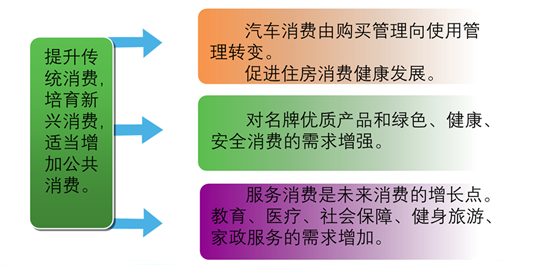
The Recommendations state that it is necessary to "enhance traditional consumption, cultivate new types of consumption and appropriately increase public consumption". Traditional consumption includes automobiles and housing, which are the two major types of consumption, and the Recommendations put forward clear requirements in this regard. Automobile consumption should be changed from purchase management to utilization management. This sentence is very good, now the national automobile purchase limit has a dozen cities, in the future as far as possible not to limit the purchase; use management is mainly to change the use of the automobile environment, the use of conditions and the use of intensity, do not limit the purchase, so that more young people to buy a car, to be able to fulfill their "automobile dream", and do not deprive the automobile of the happiness that human civilization can bring. This will enable more young people to buy cars and fulfill their "car dreams" without depriving cars of the happiness that human civilization can bring. Housing should be developed healthily in accordance with the principle of "housing only, not speculation", and housing prices should be stabilized by increasing supply, especially for low- and middle-income earners and migrant workers moving to the cities, so that they can have a housing unit that matches their income level, and so that everyone can have a house to live in.
Demand for brand-name quality products and green, healthy and safe consumption has increased. Enterprises need to meet the needs of the upgrading of the consumption structure of the population. Service consumption is the future growth point for consumption, especially the demand for education, medical care, social security, fitness and tourism, and housekeeping services will increase rapidly. In some Scandinavian countries, community service employees account for more than 50 percent of all employees in society. With the arrival of an aging society, the demand for elderly services will increase dramatically. Therefore, in the future, a large number of rural migrant workers will enter the community and become community service workers after entering the cities.
II. The key role of investment in optimizing the supply structure
The gap between urban and rural areas and regions in China is wide, the tasks of industrialization and urbanization have not been completed, the ecological and environmental debt is large, and the Fourteenth Five-Year Plan is in the stage of climbing over the "middle-income trap", so it is necessary to maintain a certain level of investment intensity.
First of all, shortcomings have to be made up, including infrastructure, municipal works, agriculture and rural areas, public health, public security, ecological and environmental protection, and so on. The short boards in these areas have to be made up. Among them, how to make up for the short board of ecological environment? The Recommendations put forward a very good sentence, that is, "to establish a mechanism for realizing the value of ecological products". Because the ecological environment, like clean air, clean water, everyone can enjoy, but clean air, clean water I contributed, paid the cost, how to recover the investment? It is impossible to compensate through market exchanges, so it is necessary to establish a special value compensation mechanism.
There are four main categories listed for mechanisms to compensate for the value of ecological products.
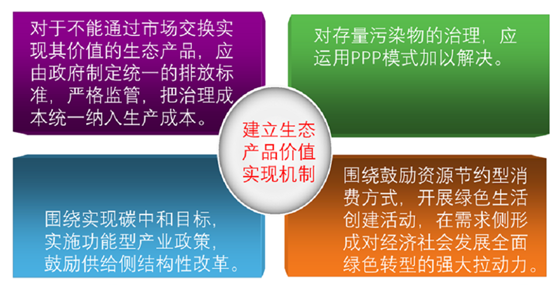
The first category, for ecological products that cannot realize their value through market exchange, should be addressed through the first channel by the Government by setting uniform emission standards, strictly regulating them, and uniformly incorporating the cost of treatment into the cost of production to provide clean air and clean water.
The second category, the treatment of stockpiled pollutants, should be addressed using the PPP model, such as garbage. Now the cumulative stock of construction waste, industrial waste and domestic waste has reached 8 billion tons, most of which is landfilled or piled up, posing the danger of groundwater pollution. How to solve it? Through some environmental governance projects, let these costing companies to do a value assessment, how much it costs to complete the governance, the financial sector to give the appropriate policy subsidies, and then through bidding, select qualified enterprises to carry out this work, including domestic enterprises, foreign-funded enterprises, state-owned enterprises, private enterprises can bid.
The third category is to implement functional industrial policies and encourage supply-side structural reforms around the goal of carbon neutrality. Carbon neutrality involves all aspects of production, consumption, distribution and allocation. We need to formulate a functional industrial policy that encourages all activities conducive to carbon reduction, whether they are production or investment, distribution or consumption, and whether they are local or foreign-funded, the government will encourage all activities conducive to carbon reduction.
The fourth category, we have to encourage resource-saving consumption patterns, to carry out activities to create a green life, in the demand side of the formation of a strong pull on the economic and social development of the overall green transformation. Citizens from childhood to establish environmental awareness, set up the concept of green consumption, such as environmental protection classes from elementary school to be taught, from the consumption side of the green transformation to form a pulling force.
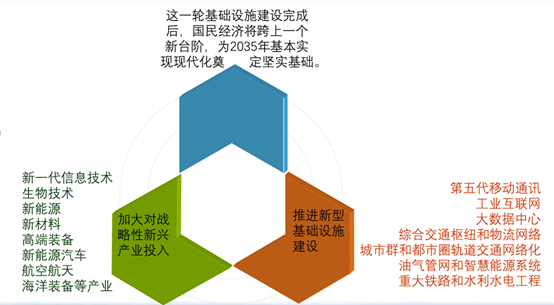
In addition, to give full play to the role of investment in optimizing the supply structure, we must also focus on a new round of infrastructure construction. After the completion of the new round of infrastructure construction, the national economy will reach a new level, laying a solid foundation for the basic realization of modernization in 2035. The new round of infrastructure construction should increase investment in strategic emerging industries, including the new round of information technology, biotechnology, new energy, new materials, high-end equipment, new energy vehicles, aerospace, marine equipment and other industries. We also need to promote infrastructure construction, including fifth-generation mobile communications, the industrial Internet, big data centers, integrated transportation hubs and logistics networks, urban clusters and metropolitan areas with networked rail transportation, oil and gas pipeline networks and smart energy systems, as well as major railroads and water conservancy and hydropower projects, among others.
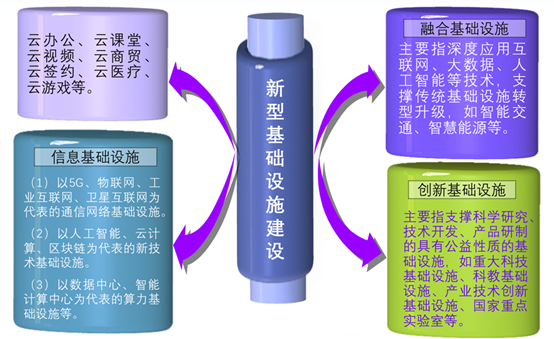
With regard to new infrastructure development, the NDRC has recently provided another explanation, dividing new infrastructure development into three broad categories. The first major category is communication infrastructure and information infrastructure, which can be divided into three subcategories. The first subcategory includes communication network infrastructure represented by 5G, Internet of Things, Industrial Internet, and Satellite Internet, the second subcategory includes new technology infrastructure represented by Artificial Intelligence, Cloud Computing, and Blockchain, and the third subcategory includes arithmetic infrastructure represented by data centers and smart computing centers. The second subcategory is convergence infrastructure, which mainly refers to the deep application of the Internet, big data, artificial intelligence and other technologies to support the transformation and upgrading of traditional infrastructure convergence infrastructure, such as intelligent transportation, smart energy and so on. Now Hangzhou has made a "city brain", the application scene has reached 47. Among them, intelligent transportation is in the traffic light intersection with cameras and artificial intelligence calculation, according to the traffic flow in all directions, to achieve flexible mediation. After intelligent management, the passage efficiency will be increased by 30%. The third major category is innovation infrastructure, which mainly refers to the infrastructure with public welfare nature that supports scientific research, technology development and product development, such as major scientific and technological infrastructure, science and education infrastructure, industrial technology innovation infrastructure, and national key laboratories. Through the construction of new infrastructures to support cloud office, cloud classroom, cloud video, cloud commerce, cloud contracting, cloud medical care, cloud games, etc., these can promote the development of the digital economy.
III. Smoothing the links between production, distribution, circulation and consumption
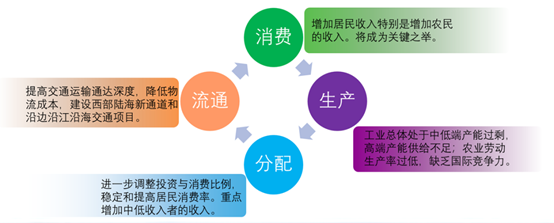
First, in the production chain, our industry is generally in a state of overcapacity and undersupply of high-end production capacity, and agricultural labor productivity is too low and lacks international competitiveness. In the distribution chain, it is mainly necessary to further adjust the ratio between investment and consumption, stabilize and increase the consumption rate of the population, and focus on increasing the income of middle- and low-income earners. In the distribution chain, it is necessary to improve the depth of transportation access, reduce logistics costs, and build new land and sea corridors in the west and transportation projects along the borders and along the rivers and coasts. Consumption link to increase the income of residents, especially the city to increase the income of farmers. If these four links can be opened up, the production process in society can be completed smoothly.
IV. Promoting positive interaction between the domestic and international double cycles
To build a new development pattern with the domestic macro-cycle as the main body and the domestic and international double-cycle promoting each other. This year, China's total sales in the domestic market will exceed those of the United States, becoming the largest market in the world. We are taking advantage of the largest market to import global resources and process them into high value-added commodities for export. We will implement the Regional Comprehensive Economic Partnership Agreement and actively consider joining the Comprehensive and Progressive Trans-Pacific Partnership Agreement. Implementing an integrated control system for domestic and foreign trade, which is a sign of a high level of openness. In the past, our per capita income and consumption levels were low, and the domestic market was in poor condition compared to foreign markets, so we had to encourage exports and control imports. Now we need to implement the neutral mediation of imports and exports, the international market, the domestic market, the neutral mediation, the establishment of a domestic trade and foreign trade integration of the regulatory system, foreign goods cheaper and better quality we import, the domestic quality goods to encourage exports. Through the regulation of imports and exports, we will improve the competitiveness of industries, enhance the fulfillment of the domestic people's consumption needs, increase the imports of high-quality products, and expand the exports of services. Implement trade and investment integration projects, and drive the export of parts, raw materials and labor through overseas investment. At the same time, through overseas investment, it is also possible to capture the global market by importing shortages of overseas resources into the country and turning them into export products after processing.
All in all, we are in a good position to accomplish the goals of the 14th Five-Year Plan and those to be realized by 2035 in accordance with the requirements of the Recommendations of the Fifth Plenary Session of the Central Committee!
Thank you!
(Arranged by the Walton Economic Institute based on the recording of Zheng Xinli's speech)